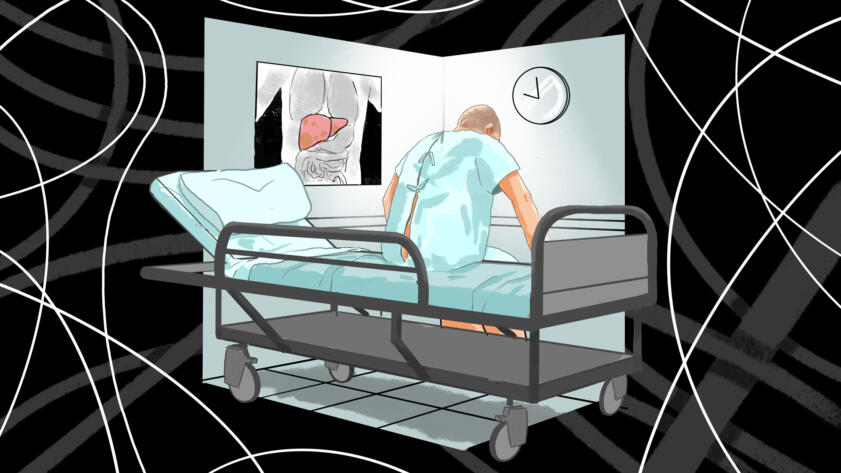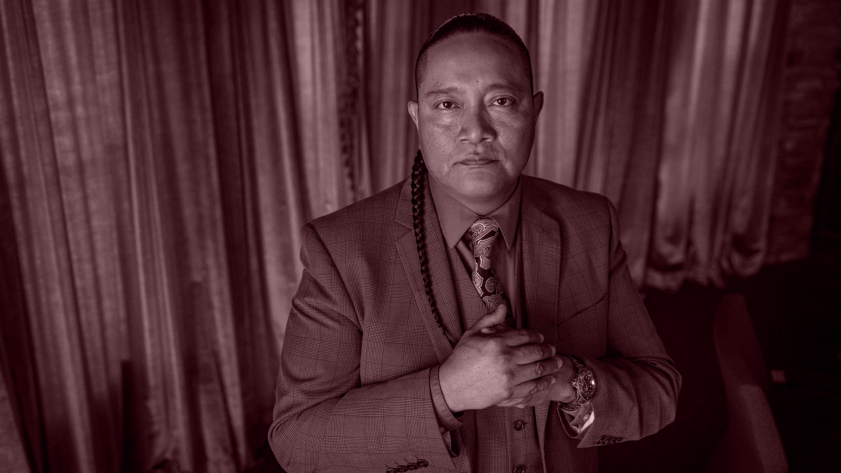Introduction
Nearly 40 years ago, U.S. policymakers sought to bring order to the growing practice of organ transplantation, convening experts from around the country to weigh in on how to get donated organs to patients in need. The group insisted fairness was essential; the government should ensure organs be allocated equitably regardless of race, wealth, or ability to pay.
See our data here
Yet transplant professionals say the ambition has never been realized. The Markup and The Washington Post sought to analyze the relationship between race and access to the liver transplant system. How does access to the national transplant waitlist and transplant surgery vary between racial groups? Which groups have the least access to the system, and why?
To conduct this analysis, The Markup and The Post used data on liver disease mortality from the Centers for Disease Control and Prevention and on liver transplants and waitlist members from the Scientific Registry of Transplant Recipients (SRTR). This data was obtained for a Markup and Post investigation into liver transplants published last year, which found that a change in national policy in the geographic allocation of donated livers led to sharp declines in transplant rates in poorer states in the Midwest and South, and sizable gains in richer states like New York and Massachusetts. Information on those datasets and how they were cleaned is summarized below and available in depth in that story’s methodology.

Organ Failure
Poorer States Suffer Under New Organ Donation Rules, As Livers Go to Waste
Life-saving liver transplants have plummeted in some Southern and Midwestern states with higher death rates from liver disease, while New York and California have made big gains
This time, instead of examining state-by-state changes in transplant rates after the policy change, our team compared racial groups, examining the number and per capita rate of liver disease deaths in the U.S. with the number of people who made it onto the liver transplant waitlist and the number of people who received transplants from 2018 to 2021.
We found that Native American people were listed for a transplant significantly less often than any of four racial groups we examined, compared to each group’s deaths from liver disease. Asian people were listed significantly more often than any other racial group, and Black people were listed for a transplant slightly less often than White people. Once someone was listed, surgery rates are about the same, regardless of race.
We wanted to understand potential reasons for the low representation of Native American communities on the liver transplant waitlist. To do so, we obtained information from the Indian Health Service about payments for 58 procedure codes related to specialist visits, liver transplants, and inpatient addiction services. We also obtained data on unmet service requests for outside care. It indicated IHS infrequently provides services needed at many stages of liver disease and addiction treatment.
Data Sources
Liver Disease Deaths and Population Data
We used data from the Centers for Disease Control and Prevention’s WONDER database on mortality from 2018 to 2021 due to end-stage liver disease, specifically, as in our prior analysis, chronic liver disease and cirrhosis (ICD-10 disease and condition codes K70, K73-K74, explained in our previous methodology). We focused on these classifications as they are the groupings associated with “Chronic liver disease and cirrhosis” within the CDC WONDER data and because they are also what the CDC uses for its own analyses of chronic liver disease deaths. This mortality data included aggregations by state, which we used in our previous investigation, and by state and racial group, also published with our previous investigation but ultimately not used in its findings. For each aggregation, it included the associated overall population and per capita death rates. The mortality data was not filtered by age. See our previous methodology for further details.

Show Your WorkOrgan Failure
How We Investigated UNOS’s Liver Allocation Policy
We found that new requirements led to plummeting transplants in some poorer states while New York and California saw big gains
Candidate Data
We also relied on data from SRTR, which provides statistical and analytical support for the Organ Procurement and Transplantation Network overseeing the U.S. organ transplant system. From its data, we culled 57,076 adult candidates in the U.S. who were added to the transplant waitlist and who were seeking a liver between January 2018 and February 2022. This includes candidates who ultimately received transplants and those who did not or who were removed from the waitlist. Information on each candidate includes their race and primary state of residence. These are the same transplant candidate records we relied on in our previous analysis, and the parameters for inclusion are detailed here.
Transplant Data
Also from SRTR, we used information on 34,526 liver transplants in the U.S. from January 2018 to February 2022. These transplants are limited to recipients who were 18 or older at the time of receiving the transplant. Information on each candidate includes their race and primary state of residence. These are the same transplant records we relied on in our previous analysis;the inclusion parameters are detailed here.
Liver-Related Health Care Claims Data
We also obtained and analyzed records from the IHS, which administers free health care to citizens of federally recognized tribes. Patients often must seek specialty care outside the agency’s facilities, and payments for these visits must be approved via the IHS’s Purchased/Referred Care program. Through a Freedom of Information Act request, The Markup and The Post requested claims paid for inpatient substance use disorder, for gastroenterologist and hepatologist visits, as well as for liver transplants from 2018 to 2022. In response, the IHS provided records of covered claims for the following procedure codes:
In-patient substance use disorder treatment
H0001- Alcohol and/or drug assessment
H0002- Behavioral health screening to determine eligibility for admission to treatment program
H0003- Alcohol and/or drug screening; laboratory analysis of specimens for presence of alcohol and/or drugs
H0004- Behavioral health counseling and therapy, per 15 minutes
H0005- Alcohol and/or drug services; group counseling by a clinician
H0008- Alcohol and/or drug services; sub-acute detoxification (hospital inpatient)
H0009- Alcohol and/or drug services; acute detoxification (hospital inpatient)
H0010- Alcohol and/or drug services; sub-acute detoxification (residential addiction program inpatient)
H0011- Alcohol and/or drug services; acute detoxification (residential addiction program inpatient)
H0014- Alcohol and/or drug services; ambulatory detoxification
H0016- Alcohol and/or drug services; medical/somatic (medical intervention in ambulatory setting)
H0017- Behavioral health; residential (hospital residential treatment program), without room and board, per diem
H0018- Behavioral health; short-term residential (non-hospital residential treatment program), without room and board, per diem
H0019- Behavioral health; long-term residential (non-medical, non-acute care in a residential treatment program where stay is typically longer than 30 days), without room and board, per diem
H0020- Alcohol and/or drug services; methadone administration and/or service (provision of the drug by a licensed program)
H0021- Alcohol and/or drug training service (for staff and personnel not employed by providers)
H0022- Alcohol and/or drug intervention service (planned facilitation)
H0026- Alcohol and/or drug prevention process service, community-based (delivery of services to develop skills of impactors)
H0033- Oral medication administration, direct observation
H0047- Alcohol and/or other drug abuse services, not otherwise specified
G0397- Alcohol and/or substance abuse structured screening and brief intervention services; greater than 30 minutes
H0049- Alcohol and/or drug screening
Gastroenterologist visits
92100- Elastography procedure; assess liver fibrosis
91010- Esophagus motility study
91110- GI tract imaging, capsule endoscopy
91065- Breath hydrogen/methane test
91122- Anorectal manometry
91035- Gastroesophageal reflux test with electrode
91037- Esophageal function test with electrode
91120- Rectal sensation test
91038- Esophageal function test > 1 hour
91034- Gastroesophageal reflux test
91040- Esophageal balloon distension test
91299- Gastroenterology procedure (other)
91112- GI wireless capsule measurement
91020- Gastric motility studies
91111- GI tract imaging, esophageal endoscopy
43756- Duodenal intubation aspiration diagnostic – single specimen
43757- Duodenal intubation aspiration diagnostic – pancreas gallbladder
78215- Liver and spleen imaging, static only
78216- Liver and spleen imaging; with vascular flow
78261- Gastric mucosa imaging
78262- Gastroesophageal reflux study
78264- Gastric emptying imaging study
78278- Acute gastrointestinal blood loss imaging
78282- Gastrointestinal protein loss
Hepatologist visits
47802- U-tube hepaticoenterostomy
47900- Suture of extrahepatic biliary duct for pre-existing injury (separate procedure)
47400- Hepaticotomy or hepaticostomy with exploration, drainage, or removal of calculus
47999- Unlisted procedure, biliary tract
78226- Hepatobiliary imaging, including gallbladder when present
78227- Hepatobiliary imaging, including when gallbladder is present; with pharmacologic intervention, including quantitative measurement when performed
Liver transplants
47135- Liver allotransplantation; orthotopic; partial or whole, from cadaver or living donor, any age
47140- Donor hepatectomy (including cold preservation), from living donor, left lateral segment only
47141- Donor hepatectomy (including cold preservation), from living donor; total left lobectomy
47142- Donor hepatectomy (including cold preservation), from living donor; total right lobectomy
47144- Preparation of cadaver donor whole liver graft prior to allotransplantation47145- Preparation of cadaver donor whole liver graft prior to allotransplantation
In-patient substance use disorder treatment
H0001- Alcohol and/or drug assessment
H0002- Behavioral health screening to determine eligibility for admission to treatment program
H0003- Alcohol and/or drug screening; laboratory analysis of specimens for presence of alcohol and/or drugs
H0004- Behavioral health counseling and therapy, per 15 minutes
H0005- Alcohol and/or drug services; group counseling by a clinician
H0008- Alcohol and/or drug services; sub-acute detoxification (hospital inpatient)
H0009- Alcohol and/or drug services; acute detoxification (hospital inpatient)
H0010- Alcohol and/or drug services; sub-acute detoxification (residential addiction program inpatient)
H0011- Alcohol and/or drug services; acute detoxification (residential addiction program inpatient)
H0014- Alcohol and/or drug services; ambulatory detoxification
H0016- Alcohol and/or drug services; medical/somatic (medical intervention in ambulatory setting)
H0017- Behavioral health; residential (hospital residential treatment program), without room and board, per diem
H0018- Behavioral health; short-term residential (non-hospital residential treatment program), without room and board, per diem
H0019- Behavioral health; long-term residential (non-medical, non-acute care in a residential treatment program where stay is typically longer than 30 days), without room and board, per diem
H0020- Alcohol and/or drug services; methadone administration and/or service (provision of the drug by a licensed program)
H0021- Alcohol and/or drug training service (for staff and personnel not employed by providers)
H0022- Alcohol and/or drug intervention service (planned facilitation)
H0026- Alcohol and/or drug prevention process service, community-based (delivery of services to develop skills of impactors)
H0033- Oral medication administration, direct observation
H0047- Alcohol and/or other drug abuse services, not otherwise specified
G0397- Alcohol and/or substance abuse structured screening and brief intervention services; greater than 30 minutes
H0049- Alcohol and/or drug screening
Gastroenterologist visits
92100- Elastography procedure; assess liver fibrosis
91010- Esophagus motility study
91110- GI tract imaging, capsule endoscopy
91065- Breath hydrogen/methane test
91122- Anorectal manometry
91035- Gastroesophageal reflux test with electrode
91037- Esophageal function test with electrode
91120- Rectal sensation test
91038- Esophageal function test > 1 hour
91034- Gastroesophageal reflux test
91040- Esophageal balloon distension test
91299- Gastroenterology procedure (other)
91112- GI wireless capsule measurement
91020- Gastric motility studies
91111- GI tract imaging, esophageal endoscopy
43756- Duodenal intubation aspiration diagnostic – single specimen
43757- Duodenal intubation aspiration diagnostic – pancreas gallbladder
78215- Liver and spleen imaging, static only
78216- Liver and spleen imaging; with vascular flow
78261- Gastric mucosa imaging
78262- Gastroesophageal reflux study
78264- Gastric emptying imaging study
78278- Acute gastrointestinal blood loss imaging
78282- Gastrointestinal protein loss
Hepatologist visits
47802- U-tube hepaticoenterostomy
47900- Suture of extrahepatic biliary duct for pre-existing injury (separate procedure)
47400- Hepaticotomy or hepaticostomy with exploration, drainage, or removal of calculus
47999- Unlisted procedure, biliary tract
78226- Hepatobiliary imaging, including gallbladder when present
78227- Hepatobiliary imaging, including when gallbladder is present; with pharmacologic intervention, including quantitative measurement when performed
Liver transplants
47135- Liver allotransplantation; orthotopic; partial or whole, from cadaver or living donor, any age
47140- Donor hepatectomy (including cold preservation), from living donor, left lateral segment only
47141- Donor hepatectomy (including cold preservation), from living donor; total left lobectomy
47142- Donor hepatectomy (including cold preservation), from living donor; total right lobectomy
47144- Preparation of cadaver donor whole liver graft prior to allotransplantation
47145- Preparation of cadaver donor whole liver graft prior to allotransplantation
IHS Unmet Needs Data
The Markup and The Post additionally sought the IHS Purchased/Referred Care program’s deferrals, patient requests that are considered lower priority or less urgent and deferred due to lack of funds. The IHS counts up deferrals in its annual “Unmet Needs” reports, and we obtained those reports for years 2016 to 2022 through a FOIA request. Our analysis focused on more recent years, 2018 to 2022.
Analyses
Liver Transplant, Waitlist, and Mortality Comparisons
To measure access to the liver transplant system, we first needed to establish the underlying need for such access for each racial group we analyzed. As an approximation for this, we relied on the per capita rate of people who died from liver disease from each racial group, based on CDC data. Not everyone who dies from liver disease would be a candidate for liver transplant, but we judged the mortality rate to be a good and readily available indicator for each group’s need.
Race is defined by the “‘Single Race’ 6 categories” field found in the CDC WONDER data. We focused on data for the White, Black, Asian, and Native American populations, as these racial groups had sufficient data on liver mortality and transplants for analysis, meaning that each accounted for at least 1% of the liver disease deaths and at least 1% of the liver transplants performed from 2018 to 2021. We excluded analysis of ethnicities, such as Latino, because members fell into numerous racial categories.
We compared the CDC mortality data, our measure of need, to a measure of access, SRTR transplant data. We did so under the assumption that an equitable system would show similar transplant and waitlist acceptance rates across racial groups when accounting for each group’s mortality.
We produced per capita rates of transplants and waitlistings using the SRTR transplant data and CDC population data, following the same approach described in our previous methodology.
The specific comparisons we made were:
- Listing-to-death ratio, the number of candidates added to the liver transplant waitlist relative to the number of people who died due to chronic liver disease and/or cirrhosis. We calculated this by comparing per capita waitlisting rate to CDC per capita death rate.
- Transplant-to-listing ratio, the number of recipients who received liver transplants relative to the number of candidates added to the liver transplant waitlist. We calculated this by comparing per capita transplant rate to per capita waitlisting rate.
The use of these specific statistics are inspired by the 2021 paper “Black Patients Have Unequal Access to Listing for Liver Transplantation in the United States” (Rosenblatt et. al.).
Wherever racial groups were named differently between the CDC WONDER “‘Single Race’ 6 categories” field and the SRTR race field, we recategorized them to align with the CDC’s categorization: Within the SRTR transplant and candidate data, “Black” was remapped to “Black or African American,” and “Native American” was remapped to “American Indian or Alaska Native.”
We tied transplant recipients and waitlist candidates to states based on the patient’s home state, using the CAN_PERM_STATE field found in both the transplant and candidate datasets. This differs from our previous investigation, in which we associated transplant and waitlisted candidates with the state for the hospital that either added them to the waitlist or conducted the transplant.
This change allowed us to more accurately capture the barriers to access that exist in certain states, especially those without any transplant hospitals, since many patients may choose to or may need to work with a transplant hospital outside of their home state when they are seeking a liver transplant. It also allowed us to directly compare a racial group’s rate of transplantation and waitlisting to their rate of death from liver disease as reported in the CDC’s data, which uses a person’s state of residence. (This is discussed in slightly more detail in our previous methodology.)
When using the CAN_PERM_STATE field for primary state of residence, we filtered out any transplants or candidates from U.S. territories (Puerto Rico, the Virgin Islands, Guam, identified in the data as “PR,” “VI,” and “GU”), as they are not present in CDC data on liver disease mortality, and any other blank values or values we believed were intended to signal unavailability (“NA,” “ZZ”). These areas collectively accounted for 371 transplants (approximately 1% of all transplants from 2018 to 2021) and 382 candidates (less than 1% of all candidates added from 2018 to 2021) removed from our analysis.
We found that Native American and Black people were listed for a transplant less often than White people were, relative to the number of deaths from liver disease within each racial group. For every 100 White people who die from liver disease, approximately 26 White people are waitlisted candidates for a liver transplant. Meanwhile, for every 100 Black people who die from liver disease, roughly 23 Black people are listed for a transplant; for every 100 Native American people who die, only 9 are listed for transplant.
The waitlist disparities between White and Black people were higher in some areas. In Washington, D.C., Arkansas, and Kansas, White people were added to the waitlist twice as often than Black people, as compared to their number of liver disease deaths.
Once on that list, each racial group receives roughly equitable access to transplants, we found.
IHS Treatments and Deferrals
To help understand why Native American communities have low representation on the transplant waitlist, we examined IHS records related to liver disease and addiction care, including transplant services, access to inpatient substance use disorder treatment, and visits to specialists who treat liver disease.
Experts we spoke to said inability to access specialists can be a barrier to getting a transplant, as can an untreated addiction. Our analysis was straightforward: We averaged patient visits and payments for services and counted up the times they were denied services requested.
According to the IHS’s claims data, on average from 2018 to 2022, the agency paid for inpatient substance use disorder treatment for 18 patients a year and paid claims for 226 patients a year to see hepatologists. Rates were similar for gastroenterologists.
We compared these services received to unmet requests for services, what’s known as deferrals. The IHS deferred nearly 113,000 patient requests to see specialists from 2018 to 2022, including 6,196 requests to see gastroenterologists. Requests to see hepatologists were not broken out in IHS records.
Claim data shows the agency chipped in an average of $11,200 per patient to the cost of liver transplantation. We compared this to an estimate of the average billed for the procedure, $650,000, in a report from Milliman, an actuarial and consulting firm.
From 2018 to 2022, IHS kicked in funding for six liver transplants. During the same period, it deferred 105 requests for transplants for all organ types.
Limitations
Since our analysis focuses on data from 2018 to 2021, there are unknown complications from the emergence of COVID-19 in the middle of the analysis period. As we previously noted, the Organ Procurement and Transplantation Network and others in the industry have not yet fully analyzed and understood the full impacts that the COVID-19 pandemic has had on transplant rates throughout the country, and thus we cannot account for some of these factors. IHS spokesperson Nicole Adams noted that during the COVID-19 pandemic, IHS referrals for outside care were “temporarily halted due to the redirection of services” to treating the virus. She was unable to provide specific dates for the pause so we were unable to factor it into our analysis.
Older people who die from liver disease could also complicate our analysis. Experts we spoke to explained that prospective candidates for liver transplant who are older than 70 are less likely to be found eligible for the surgery due to factors such as comorbidities and whether they would survive the procedure. This means that racial groups with a disproportionate number of liver deaths after age 70 may have more access to the transplant system than implied by the ratios we relied on to gauge access.
The CDC WONDER mortality data was not filtered by age, making it an imperfect set to compare to our transplant and waitlist data, which was filtered to only include adults. Children accounted for 24 deaths from liver disease in CDC WONDER data from 2018 to 2021 — about 0.01% of the total.
The IHS claim data provides an incomplete picture of all addiction services provided to tribal citizens. The agency outsources a large proportion of its addiction services to tribal programs, and in these cases the services do not appear in the data we examined.
IHS’s “Unmet Needs” reports do not account for all unmet needs in Indian Country. According to Adams, 39% of tribes manage their own health care and are not required to report data for IHS’s Purchased/Referred Care program.
Responses
The Markup and The Post shared our findings of racial inequities in access to the liver transplant list with key officials. In the United States, the Organ Procurement and Transplantation Network is administered by the government contractor United Network for Organ Sharing and overseen by the Health Resources and Services Administration, an agency of the U.S. Department of Health and Human Services. In written statements, UNOS spokesperson Anne Paschke and HRSA spokesperson Martin Kramer both said their institutions are working toward equity, but neither responded to questions specific to our statistical findings.
In response to The Markup and The Post’s finding that the Indian Health Service infrequently provides services to treat and prevent liver disease, according to the data it provided, Adams said in a written statement, “Many sites were limited to authorizing payment solely for life and limb-threatening emergencies.” She said that recent changes, including the implementation of Medicare-like reimbursement rates, have allowed the agency to stretch its dollars further and provide more services. Additionally, any deferred service requests—such as those for transplants or liver specialist visits—may be approved at a later date.
Conclusions
We found significant racial disparities in access to liver transplant waitlists as measured by the ratio of the number of people accepted to the transplant candidate list compared to the number of people who died from liver disease. People from Native American communities had the worst access, with 9 patients accepted for every 100 deaths, while Asian people had the best access, with 68 people accepted for every 100 deaths.
We did not see such disparities when analyzing who on the waitlist receives liver transplants.
Our examination of IHS claims data indicated that low access to specialist care and addiction treatment may help explain the disparities in Native American communities.





